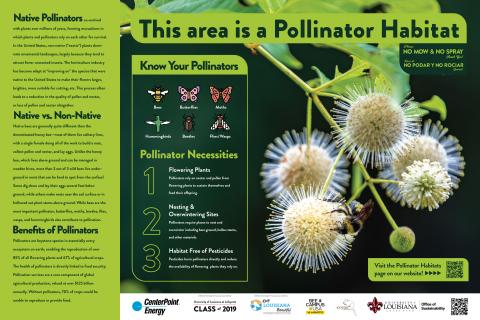Pollinators and Pollinator Habitats
A pollinator habitat planting consists of native shrubs, grasses and/or wildflowers which provide cover, nectar and pollen for native pollinators. Pollinators are an insect or other agent that conveys pollen to a plant and so allows fertilization. Native pollinators in Louisiana include a wide range of insects including bees, beetles, butterflies, and moths, as well as birds. To encourage and support a diverse group of pollinators a diverses selection of grasses and wildflowers are encouraged.
We have numberous pollinator locations on campus. To see the list of pollinator locations on campus visit the Bee Campus USA webpage. Many pollinator habitats are also used as Living Labs and intergrated into courses and reasearch.
All of UL Lafayette Green Infrastructure projects are also pollinator locations. To learn more about the Green Infrastructure projects on campus visit the Green Infrastructure webpage. Native Pollinators
Native pollinators coevolved with plants over millions of years, forming mutualisms in which plants and pollinators rely on each other for survival. In the United States, non-native (“exotic”) plants dominate ornamental landscapes, largely because they tend to attract fewer unwanted insects. The horticulture industry has become adept at “improving on” the species that were native to the United States to make their flowers larger, brighter, more suitable for cutting, etc. This process often leads to a reduction in the quality of pollen and nectar, or loss of pollen and nectar altogether.
Native vs Non-Native Pollinators
Native bees are generally quite different than the domesticated honey bee – most of them live solitary lives, with a single female doing all of the work to build a nest, collect pollen and nectar, and lay eggs. Unlike the honey bee, which lives aboveground and can be managed in wooden hives, more than 2 out of 3 wild/native bees live underground in nests that can be hard to spot from the surface! Some dig down and lay their eggs several feet below ground, while others make nests near the soil surface or in hollowed out plant stems above ground. While bees are the most important pollinator, butterflies, moths, beetles, flies, wasps, and hummingbirds also contribute to pollination.
Native plants have deep root systems that help with stormwater management. The extensive and deep root systems of native plants slow down runoff, reduce soil erosion along river and stream banks, and absorb dirty water before it gets into the nearby waterways.
Threats
Up to 40% of pollinator species on earth are at risk of extinction in the coming years as a result of a variety of environmental stressors including habitat loss, exposure to pesticides, diseases and pathogens, and climate change. Unwanted species of plants, animals, and microbes are often controlled with pesticides (an umbrella term that includes—but is not limited to—insecticides, herbicides, fungicides, and rodenticides). Pesticides often negatively impact beneficial species in addition to those they aim to control. Contamination resulting from the extensive use of pesticides has been tied to the decline of species important to ecosystems, including pollinators. On the UL Lafayette campus we only use pesticides in a last resort situations in a monitored manner.
Benefits
Help to ensure the survival of vital animal species crucial to our planet's functioning ecosystems. Pollinators are keystone species in essentially every ecosystem on earth, enabling the reproduction of over 85% of all flowering plants and 67% of agricultural crops. Food grows and improves local food production through expanded pollination
Campus Pollinator Habitat Locations
- Billeaud Hall Monarch Garden
- Billeaud Hall LA Certified Habitat
- Urban Cajun Prairie / Bioswale
- Butterfly Garden and Community Garden at Cajun Village
- Bourgeois Park: Cajun Prairie Planting near bridge / Cajun Prairie Riparian Buffer along Coulee(Don't be alarmed if these gets cut. These get cut back to 18" 1-2 times per year for the health of the habitat)
- Fletcher Hall Raingarden
- Wharton Hall Bioswale The first bioswale on campus was planted in 2016
- Student Union Raingarden
- Hamilton Hall Pollinator Gardens
- UL Lafayette Science Museum Pollinator Gardens
- Pollinator Habitat Lab next to the Cabbage Patch
- Recently Completed: Judice Rickels Butterfly/Bioswale
- Recently Completed with help from Acadiana Native Plant Project: Hilliard Pollinator Garden/ Rain Garden

Special Thanks
We would like to thank CenterPoint Entergy for funding the Living Lab Signage Project so we can turn campus into a living lab with informational signs that call attention to the special landscapes of our beautiful campus. The first phase of signs will placed on campus in 2023.
Additional thanks goes to Keep Louisiana Beautiful and the Class of 2019 for their contrubution to this project.

